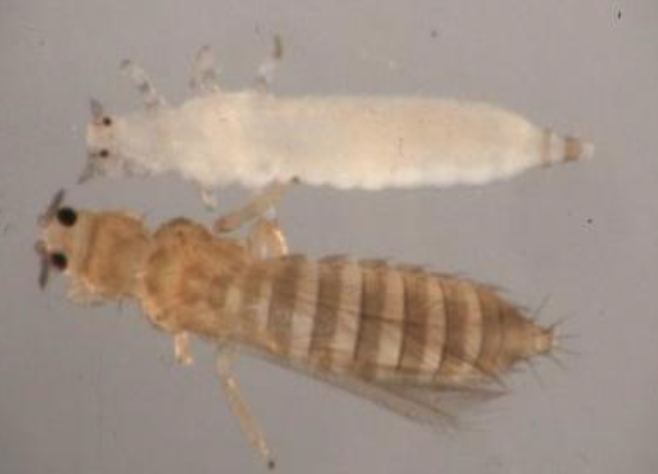Banana silvering thrips (Hercinothrips bicinctus)
Credit: Biovision-Infonet

(c) Courtesy EcoPort (http://www.ecoport.org): Alton N. Sparks, Jr., The University of Georgia

(c) A. M. Varela, icipe
Banana-silvering thrips are small (1.5 mm long), slender, brown insects with pale yellow hind wings that appear as a yellow line down the back of the body when the insect is at rest. Adult thrips have characteristic wings; the transparent wings have a fringe of hairs around the outside edge standing out in the same plane as the wing. The tiny eggs are laid just into the plant tissue on the pseudostem or where 2 fruits touch. The nymphs hatch after 7 or 8 days, are pale yellow or white in colour and often have a black globule of excrement at the end of the abdomen. The larval stage lasts about 10 days after which the nymphs move down into the soil to pupate. Adults emerge after a further 7 to 10 days.
The banana silvering thrips is found in tropical and subtropical regions, they are polyphagous and particularly found on bananas. They feed on the skin of the fruit causing silvering patches (hence the common name of the insect), which turn brown and may cover the whole fruit and deep longitudinal cracks may appear as a result.
What to do:
- To prevent this insect spreading, do not use planting bits and suckers from areas infested with silvering thrips.
- Bagging of bunches has been found to prevent thrips infestation. For more information on Bagging click here
- Conserve natural enemies. Thrips are attacked by predatory thrips, lacewings and predatory bugs. Avoid use of pesticides that kill natural enemies.
- Whenever necessary spot spray the crop with botanicals or other biopesticides. Some plant extracts (e.g. garlic, rotenone, neem, pyrethrum, and a mixture of garlic and pepper) are reported to control thrips. Spinosad, a bacterial derivative, is effective in controlling thrips.